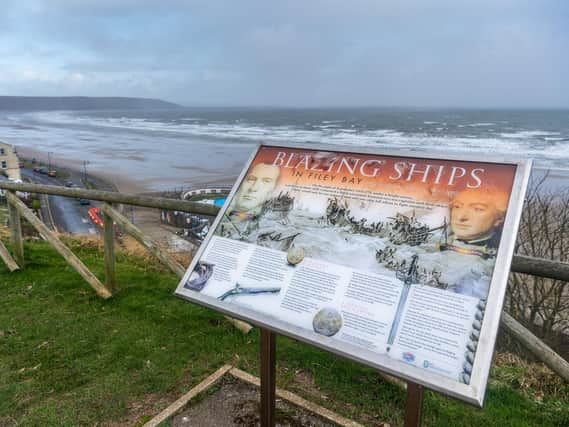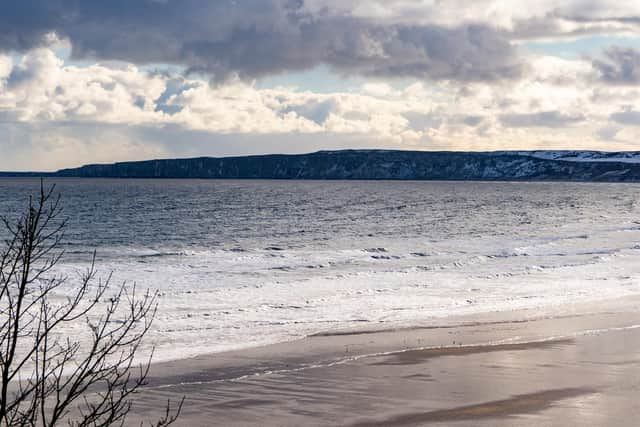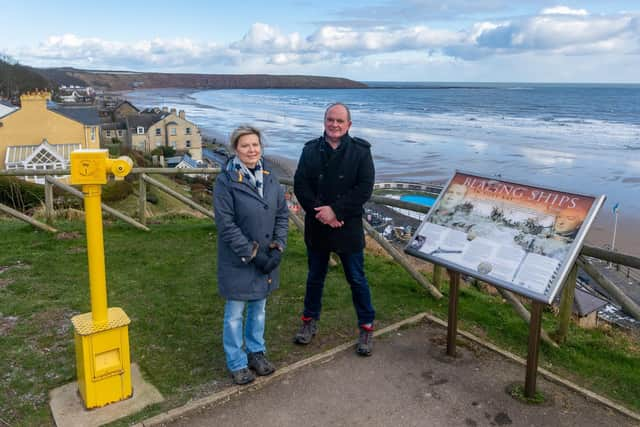How the fascinating story of the wreck of the Bonhomme Richard could attract American visitors to the Yorkshire coast


In 1779, the people of Filey gathered on the cliffs to watch the American Revolutionary War unfold before them, as the Bonhomme Richard - a French-built vessel commandeered by a Scottish pirate fighting under the American flag - took on the might of the Royal Navy.
Captain John Paul Jones claimed victory over the British warship Seraphis, but the Bonhomme Richard paid the price, and sunk in a storm after sustaining fatal damage.
Advertisement
Hide AdAdvertisement
Hide AdThe Seraphis and a less-vaunted ship, the Whitby-built Countess of Scarborough, had been protecting a merchant convoy carrying naval supplies for British dockyards when they were harassed by Jones, but the Countess' heroic actions enabled most of the vessels to escape and reach safety at Scarborough Castle, leaving the Seraphis to her fate.


In 2018, it was announced that a wreck close to Filey Bay had been identified as that of the Bonhomme Richard, having previously been mistaken for another vessel. The discovery seemed to finally end speculation over the ship's resting place, and Harrogate-based marine archaeological consultancy Merlin Burrows announced their find to great fanfare. Three years on, they are still awaiting verification from HM Receiver of Wreck.
Yet for the dozen members of the Filey Bay Bonhomme Richard Research Group, the location of the wreck is almost superfluous to their eventual aim - of commemorating the Battle of Flamborough Head and attracting American tourists to Filey and the stage where a 'world event' took place.
They have instead concentrated on researching the impact the battle had on the local communities, the origins of the crews who fought in it, and the merchants who saw an opportunity to profit from discord with a new global power.
Advertisement
Hide AdAdvertisement
Hide AdJames and Kim Hodgson, Tony Green and Dr David Pendleton are ambitious - they want to secure corporate sponsorship, hold an annual festival, fund a visitor centre and convince the First Lord of the Admiralty to visit Filey.


As Kim, an American who studied the Battle of Flamborough Head at school, points out, there is a lack of awareness of British waters being part of the theatre of the American War of Independence.
"As a group, we want to focus on the battle itself - regardless of the wreck, we know it happened in Filey Bay. There is a museum in John Paul Jones' birthplace, Dumfries, but in Filey there is only a plaque and a toposcope. In the US, we think we won the battle - but the English would beg to differ! Our countries are friends now and it's about recognising the historical link and drawing people over here, where the action was."
As experienced researcher Tony attests, a lack of reliable records meant that there has long been dispute over the location of the Bonhomme Richard, leading to decades of expensive and fruitless searches all over the Yorkshire coast.
Advertisement
Hide AdAdvertisement
Hide Ad"Americans have this quite fixed view of it, but the stories and accounts of the battle were written around 30 years after it took place. A lot of the timings were incorrect, and things like the tidal information and other factors. There is scepticism in the US about Merlin Burrows' discovery, but to me, on a balance of probabilities, it is the Bonhomme Richard. Everything fits - but there are politics involved.
"There are a lot of unique features which generate interest in the battle - it was a real turning point in history, the first incidence of US sea power.
"The location is a lot closer to the beach than previously thought, but it's a very dangerous area of the coast where the lifeboat is often called out to trapped people. We wouldn't encourage people to go right up to it."
The group has taken the unusual decision to eschew potential grants from public bodies such as the National Lottery Heritage Fund, preferring instead to seek private sponsorship from American and British businesses.
Advertisement
Hide AdAdvertisement
Hide AdTheir plan is to hold a major commemorative event on the 250th anniversary of the battle in 2029, and they hope to invite the US Navy to send a warship to Filey.
Until then, they will mark John Paul Jones' birthday and look to erect a clifftop monument as a focal point that could persuade American visitors to detour from the well-trodden path between London and York.
For David, who also chairs Filey Literature Festival, the real story of the Battle of Flamborough Head lies in its local resonance - and the under-rated role played by the Countess of Scarborough, a small 20-gun sloop commanded by an illegitimate son of the Duke of Northumberland.
The Countess was hardly a jewel of the fleet, yet she 'made a nuisance of herself' long enough for the convoy to escape.
Advertisement
Hide AdAdvertisement
Hide AdDavid has also researched the provenance of the crew, and after discovering adverts for men in the Leeds Intelligencer newspaper - a forerunner to the Yorkshire Post - he believes they may have been 'adventurers' from all over Yorkshire serving alongside seamen recruited from the more likely ports of Hull, Bridlington and Scarborough. It was the sailors' pubs in Hull Old Town where they were sent to sign on.
"The Countess was a tiny ship built in Whitby, but it took two French frigates to subdue her. It was a very belligerently Yorkshire action!"
David discovered the involvement of Hull merchant William Hammond, a shipbuilder who sold vessels to Captain Cook and whose son George later became the first British ambassador to the US.
He has traced a full crew list to the National Archives, and uncovered the story of a daring escape of a group of would-be prisoners who managed to reach the shore at Butchers Haven, a mile south of Filey, in a boat and surrender to the lord of the manor at Hunmanby.
Advertisement
Hide AdAdvertisement
Hide Ad"Locals watched the battle from the cliffs, as it was a moonlit night. There were cannonballs bouncing off Bempton Cliffs - it was a very exciting local event and a bit of entertainment.
"It's become so iconic that sifting legend from fact has proved difficult, and there is controversy and identity politics involved. Some battles still have that legacy of tension, but in this case, a major world event happened in our bay, and we now have friendship with the Americans."
Tony added: "We differ to the US in some ways, but we want to focus on Filey and provide that link to bring people here. Coastal economies suffer from their peripherality, and we are considered an impoverished area. We want to promote what we have - it deserves to be brought to the fore."